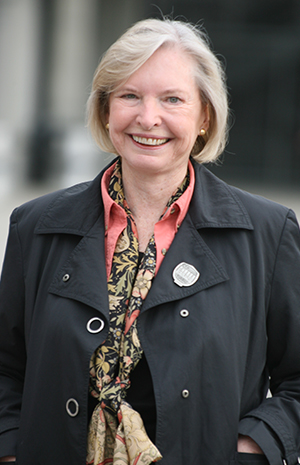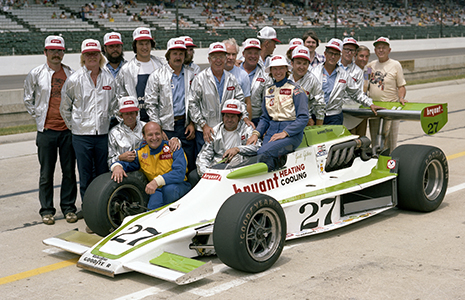Documentary traces Guthrie's battle to prove she's 'Qualified'
MAY 28, 2019
(Watch the premiere of “Qualified” at 8 p.m. ET Tuesday on ESPN.)
The 1977 Indianapolis 500 produced a series of firsts.
Tom Sneva became the first racer to break the 200-mph barrier at Indianapolis Motor Speedway. A.J. Foyt became the first driver to win four Indianapolis 500 races. And most significantly — at least from a cultural standpoint — Janet Guthrie became the first woman to qualify for and compete in the world-famous race.
Until 1971, IMS prohibited women from entering the press box, garage and pits. The speedway rescinded these rules only after a female reporter successfully sued. A woman on track — even one who, like Guthrie, had raced successfully sports cars for 13 years — well, it was unthinkable.
 So, of course, Guthrie’s arrival at Indianapolis provoked howls of protest among drivers, reporters and fans. Some said a woman couldn’t handle the horsepower and speed of an Indy car. Others simply believed that the racetrack was no place for a lady.
So, of course, Guthrie’s arrival at Indianapolis provoked howls of protest among drivers, reporters and fans. Some said a woman couldn’t handle the horsepower and speed of an Indy car. Others simply believed that the racetrack was no place for a lady.
“The fuss wasn’t really about me,” says Guthrie. “The fuss was about the cultural mindset as to what women could and should — or couldn’t and shouldn’t — attempt.”
In time, Guthrie’s performance on track silenced even her most vocal critics. She qualified for the Indianapolis 500 three times. In 1978, she finished in ninth place — just two spots behind Foyt and ahead of Mario Andretti, Johnny Rutherford, and Rick Mears. (Incidentally, she drove that race with a fractured right wrist.)
Guthrie also competed in NASCAR, becoming top rookie at the Daytona 500 and finishing a career-high sixth at Bristol in 1977. “There was only one way I could bring the skeptics around, and that was on the racetrack,” Guthrie says. “As time went on and they discovered that I knew what I was doing, attitudes did change, and that was very gratifying.
“I really felt on top of the world,” Guthrie says of that period. “I had a lot to look forward to.”
Yet incredibly, Guthrie could not attract the money needed to run at the front, or indeed at all.
“I had to suspect it had something to do with my being a woman,” she says. “There didn’t seem to be any other reason that someone with my record wouldn’t find backing.”
And “without money in racing, you’re just a fast pedestrian.” Demoralized and depressed, Guthrie hung up her helmet in 1983.
At the peak of her racing career, Guthrie was a household name, often spoken in the same breath as the monikers of feminist icons like Billie Jean King. But in time, Guthrie faded from public view. Eventually, few people outside of racing knew of her at all.
This was certainly true for filmmaker Jenna Ricker. After attending her first Indianapolis 500 some years back, Ricker says, “I realized that I didn’t know who the first woman to qualify for and race in the Indianapolis 500 was — and I probably wasn’t the only one.”
After some rudimentary research, Ricker resolved to restore Guthrie to the pantheon of racing and of the women’s movement by developing a documentary about the driver.
The resulting film, produced by Oscar winner Caroline Waterlow and aptly titled “Qualified,” is the latest installment of ESPN’s popular and prestigious “30 for 30” series. “Qualified” focuses primarily on Guthrie’s failed attempt to qualify for Indianapolis in 1976, her successful attempt in 1977 and her highest finish in 1978, as well as her NASCAR career. It premieres at 8 p.m. ET Tuesday on ESPN.
Archival footage, vintage photos and contemporaneous newspaper headlines — many appallingly insulting toward women in general and Guthrie in particular — complement interviews with and narration by Guthrie, Foyt, Rutherford, crew members and other racing insiders. For anyone intrigued by the hallowed history of Indy, “Qualified” qualifies as a must-see.
 Guthrie’s contributions to racing (and society) cannot be overstated. Since she kicked open the door at Indianapolis in 1977, eight more women have charged through — most recently Pippa Mann, who finished a career-best 16th Sunday in her seventh Indianapolis 500 presented by Gainbridge. Like Guthrie in 1978, Mann placed higher on Sunday than a pair of past Indy 500 winners, Scott Dixon and Helio Castroneves.
Guthrie’s contributions to racing (and society) cannot be overstated. Since she kicked open the door at Indianapolis in 1977, eight more women have charged through — most recently Pippa Mann, who finished a career-best 16th Sunday in her seventh Indianapolis 500 presented by Gainbridge. Like Guthrie in 1978, Mann placed higher on Sunday than a pair of past Indy 500 winners, Scott Dixon and Helio Castroneves.
Many of the women who followed Guthrie have produced their own firsts. Sarah Fisher became the first woman to finish an Indy car race on the podium (second at Homestead-Miami Speedway in 2001) and win a pole position (Kentucky Speedway in 2002). Danica Patrick became the first woman to lead the Indianapolis 500 (2005) and to win an Indy car race (Twin Ring Motegi in 2008). Patrick also became the first woman to win a NASCAR Cup series pole (Daytona in 2013).
“It’s no longer front-page news when a woman is driving at Indianapolis,” says Guthrie, indicating a change for the better. Yet Guthrie downplays her achievements.
“I was in the right place at the right time with the right background of experience, dedication and passion,” she says of her trailblazing career. As for the rest, she says, “If what I did turned out to be helpful to other women, then I am glad of that. But that is not why I did what I did. I did it because I was a racing driver through to my bone marrow.”






















